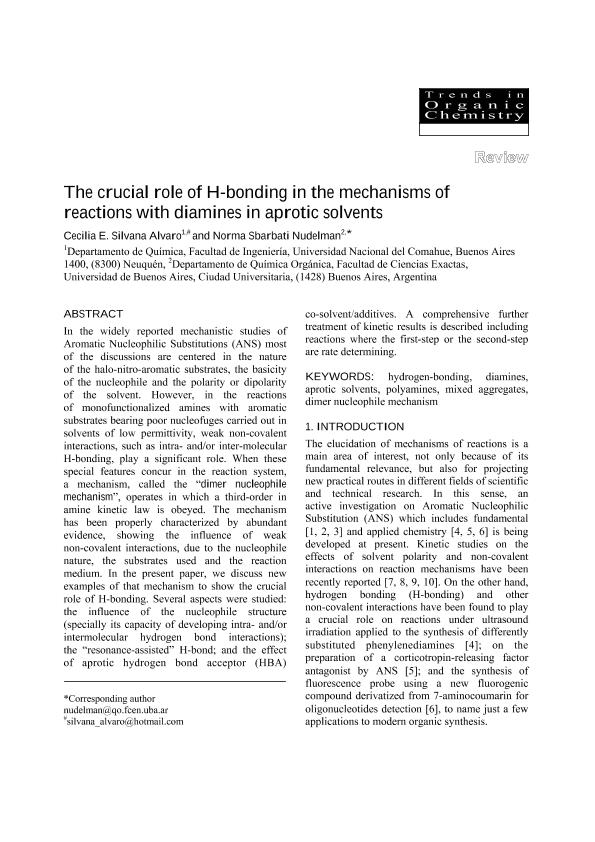Mostrar el registro sencillo del ítem
dc.contributor.author
Alvaro, Cecilia Elisabeth Silvana

dc.contributor.author
Sbarbati, Norma Ethel

dc.date.available
2019-01-23T18:45:22Z
dc.date.issued
2011-07
dc.identifier.citation
Alvaro, Cecilia Elisabeth Silvana; Sbarbati, Norma Ethel; The crucial role of H-bonding in the mechanisms of reactions with diamines in aprotic solvents
; Research Trends; Trends in Organic Chemistry; 15; 7-2011; 95-107
dc.identifier.issn
0972-4362
dc.identifier.uri
http://hdl.handle.net/11336/68468
dc.description.abstract
In the widely reported mechanistic studies of Aromatic Nucleophilic Substitutions (ANS) most of the discussions are centered in the nature of the halo-nitro-aromatic substrates, the basicity of the nucleophile and the polarity or dipolarity of the solvent. However, in the reactions of monofunctionalized amines with aromatic substrates bearing poor nucleofuges carried out in solvents of low permittivity, weak non-covalent interactions, such as intra- and/or inter-molecular H-bonding, play a significant role. When these special features concur in the reaction system, a mechanism, called the “dimer nucleophile mechanism”, operates in which a third-order in amine kinetic law is obeyed. The mechanism has been properly characterized by abundant evidence, showing the influence of weak non-covalent interactions, due to the nucleophile nature, the substrates used and the reaction medium. In the present paper, we discuss new examples of that mechanism to show the crucial role of H-bonding. Several aspects were studied: the influence of the nucleophile structure (specially its capacity of developing intra- and/or intermolecular hydrogen bond interactions); the “resonance-assisted” H-bond; and the effect of aprotic hydrogen bond acceptor (HBA) co-solvent/additives. A comprehensive further treatment of kinetic results is described including reactions where the first-step or the second-step are rate determining.
dc.format
application/pdf
dc.language.iso
eng
dc.publisher
Research Trends
dc.rights
info:eu-repo/semantics/openAccess
dc.rights.uri
https://creativecommons.org/licenses/by-nc-sa/2.5/ar/
dc.subject
Hydrogen Bonding
dc.subject
Diamines
dc.subject.classification
Otras Ciencias Químicas

dc.subject.classification
Ciencias Químicas

dc.subject.classification
CIENCIAS NATURALES Y EXACTAS

dc.title
The crucial role of H-bonding in the mechanisms of reactions with diamines in aprotic solvents
dc.type
info:eu-repo/semantics/article
dc.type
info:ar-repo/semantics/artículo
dc.type
info:eu-repo/semantics/publishedVersion
dc.date.updated
2019-01-17T13:59:18Z
dc.journal.volume
15
dc.journal.pagination
95-107
dc.journal.pais
Estados Unidos

dc.description.fil
Fil: Alvaro, Cecilia Elisabeth Silvana. Universidad Nacional del Comahue. Facultad de Ingeniería. Departamento de Química; Argentina
dc.description.fil
Fil: Sbarbati, Norma Ethel. Universidad de Buenos Aires. Facultad de Ciencias Exactas y Naturales. Departamento de Química Orgánica; Argentina. Consejo Nacional de Investigaciones Científicas y Técnicas; Argentina
dc.journal.title
Trends in Organic Chemistry
dc.relation.alternativeid
info:eu-repo/semantics/altIdentifier/url/http://www.researchtrends.net/tia/abstract.asp?in=0&vn=15&tid=14&aid=3323&pub=2011&type=3
Archivos asociados
